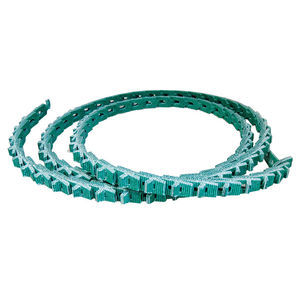
- Power Transmission - Mechanical components
- Mechanical Transmission
- Poly V belt
- Tempo International
- Company
- Products
- Catalogs
- News & Trends
- Exhibitions
Wrapped belt Vfabricindustrial
Add to favorites
Compare this product
Characteristics
- Type
- V
- Material
- fabric
- Sector
- industrial
- Other characteristics
- low-noise, wrapped, abrasion-resistant, oil-resistant
Description
Wrapped belts could be considered the standard v-belt. The term wrapped comes from fabric that covers the internals of the belt, giving it a very uniform look and feel, as well as reasonably quiet operating characteristics.
The purpose of the wrap is two-fold. The fabric provides abrasion resistance, which makes the belt more durable. The contact between the belt and sheave is constant and can occur at very high speeds. This extra protection against contamination and wear of both belt and sheave, allows the belt to operate longer before it becomes too worn to transmit the required power properly.
Another benefit, which can be critically important in the applications that require it, is belt slip. While a v-belt slipping within a sheave can seem counter-intuitive, it can prevent significant damage. When a torque spike occurs, or a sudden change in the drive speed causes the belt drive to respond in kind, a wrapped belt will slip more easily than a raw-edge. Most of the time, the belt will snap before transmitting power back into the gearbox or motor, so the belt’s ability to slip is a safety factor.
Lastly, the fabric wrapping has high oil resistance. Raw edge belts have a possibility of becoming clogged with contaminants and absorbing moisture. This will lead to swelling of the belt rubber and cause breakage.
Catalogs
No catalogs are available for this product.
See all of Tempo International‘s catalogsRelated Searches
- Power transmission belt
- Industrial power transmission belt
- Rubber power transmission belt
- Plastic strip
- Timing belt
- Industrial belt
- Sturdy belt
- PU belt
- V belt
- Metal pulley
- Oil-resistant power transmission belt
- Toothed pulley
- Trapezoidal power transmission belt
- Flexible belt
- High-resistance power transmission belt
- Abrasion-resistant strip
- Groove pulley
- Heat-resistant power transmission belt
- Endless power transmission belt
- Timing pulley
*Prices are pre-tax. They exclude delivery charges and customs duties and do not include additional charges for installation or activation options. Prices are indicative only and may vary by country, with changes to the cost of raw materials and exchange rates.





